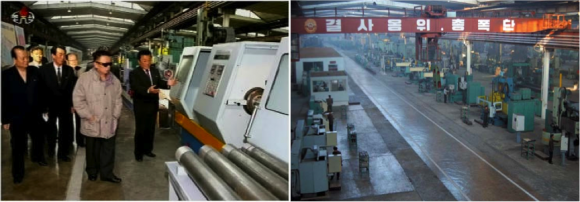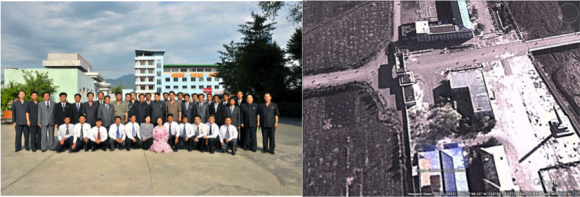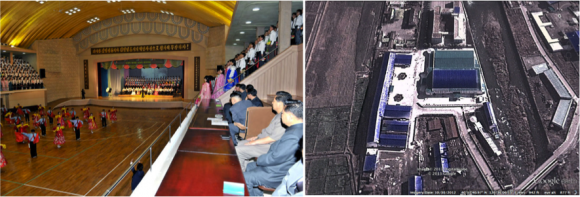I have a post up at 38North with my colleague Amber Lee looking at two sites linked to North Korea’s centrifuge program – the Huichon Ryonha General Machine Factory and the Kanggye General Tractor Plant.
These plants have several different names over time and undergone a fair amount of modernization. It isn’t always easy to determine if a particular place visited by Kim Jong Il under one name is the same as another place with a different name visited by his son.
The process of matching names, places and visits is pretty labor intensive. It’s also long and somewhat confusing — so I left it out of the piece for 38 North which was already way too long.
This post makes explicit some of these judgements. There are yet more pictures to analyze, but this is a first cut.
To a first approximation, I think Huichon makes machine tools, while Kanggye uses those tools to manufacture munitions, misiles and maybe, just maybe, centrifuges.
Huichon Ryonha
Huichon seems to be the major center for the production of CNC machine tools in the DPRK.
There is an issue of the name: Until mid-2010, state media referred to the Huichon General Machine-Tool Plant. After mid-2010, state media instead referred to either the Huichon Ryonha General Machinery Plant or the Ryonha General Machinery Plant.
These are all the same facility.
In 2011, KCNA reported that Kim Jong Il had visited the Huichon Ryonha facility “several” times. (He sent them an autograph.) KCNA, however, records only one visit under the “Huichon Ryonha” name suggesting that previous visits occurred under a different name. During a December 2010 visit, Kim Jong Il seemed to confirm that, noting the facility “has undergone radical changes in a matter of a few months.” The implication is that the facility was the same one he visited under a different name in May 2009 and March 2010.
We can match internal and external images provided by the DPRK with satellite images. These are clearly consistent with a site that was substantially remodeled in mid-2010, coinciding with the renaming of the facility.
When Kim Jong Il visited in 2009, he was kind enough to stand in front of a map of the complex. Although the map was an artist’s conception of what the site would eventually look like (rather than a faithful rendering), the buildings are distinct enough to match to an industrial site in Huichon. Here are two comparisons.
One does not expect an artist’s conception to match the resulting buildings perfectly, but the agreement is still excellent. The artist drawing largely concerns a new casting shop. The casting shop help links the 2009 visit to the “Huichon General Machine Tool Plant” with the 2010 visit to the Huichon Ryonha General Machinery Plant. In 2009, Kim saw plans for the casting shop, while in 2010 he noted that it had been completed.
The only discrepancy between the artist’s illustration and the site today is the large blue roofed building, which is depicted in 2009 as having a saw-tooth roof. This turns out to be very helpful.
This building is where Kim Jong Il is standing. Two images — one of image of Kim and another of the inside of the Huichon Ryonha General Machinery Plant — show the interior of the roof. Prior to 2010, the main factory at Huichon General Machinery Plant had a saw-tooth rood with distinctive lighting.
After North Korea renamed the facility, it also replaced the building. An external image released by the Huichon Ryonha General Machinery Plant corresponds to the building with a peaked, blue roof. When Kim returns in December 2010, the building has been completely replaced. This is why Kim is commenting on the “dramatic” changes in just a few months. It’s a totally new building.
This new building matches perfectly the physical description of the “main” Ryonha facility provided at a trade fair. An official noted that there were two Ryonha facilities – one in Pyongyang and another in Huichon. He noted that the “main” facility had a floor-space of 40,000 square meters and was the largest facility of its kind “in the world.” The main building at Huichon, which Kim Jong Il visited several times, has a floorspace of approximately 40,000 square meters.
(I don’t know what to make of the claim that Ryonha has a smaller facility near Pyongyang. US sanctions information suggests the site is in Mangyongdae and there is what purports to be an external image of the site floating around. I simply could not find a match to the image or other open source information that would identify the location of the site, nor could Curtis Melvin.)
Kanggye Tractor Factory
This one is more straight-forward, since defector accounts have indicated that the Kanggye General Tractor Plant is better known as the “No. 26 Factory” that produces munitions including ballistic missiles, artillery shells and torpedos. The location was even printed on a map in a Japanese book Kin sei nichi daizukan (Great Illustrated Book of Kim Chong-il), written by a Japanese journalist named Osamu Eya. (I have a terrible photocopy of the map, which also appeared in a a Japanese magazine.)
Still, it is nice when everything matches up.
The easiest identification is that Kim posed with workers near the front gate. The buildings around the front gate are very distinct.
Moreover, Kim attended a performance in a recently constructed athletic facility with a distinctive curved roof. There aren’t other buildings in the area that match all three criteria: size, roof-type and recency.
The site also agrees pretty well with the descriptions of a defector. The site matches a map drawn by a defector about as well as one can expect from a crude map drawn from recollection twenty years ago. (Sadly, I can’t republish the map. I am working on fixing that.)





